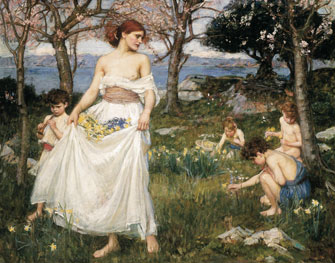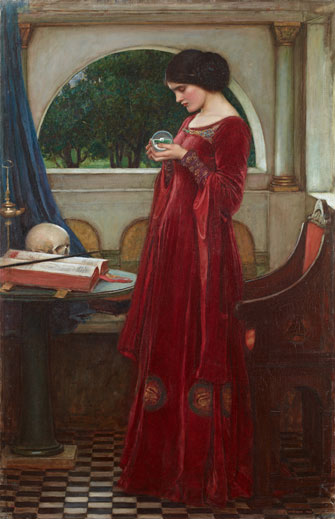English Love Affair with
Erotic Sensuality

“A Song of Springtime” (1913), by John William Waterhouse. Photo © Studio Sébert Photographes
In the 18th and early 19th centuries, the English were a pretty rakish lot. Victorian prudery drove that tendency underground, but the collection of Pre-Raphaelite and Romantic paintings now on show at the Jacquemart André Museum demonstrates that the English love affair with erotic sensuality was never fully extinguished.
“Désirs et Volupté” brings together 50 paintings by some 20 artists, mostly executed in the later decades of the 19th century, the high Victorian period. Under a veil of mock-Medievalism and neoclassicism, the common theme is carnal delight, expressed with extraordinary painterly virtuosity. While their Continental cousins were rebelling against academic art, with modernist explorations of light, texture and the mechanical age, the English were pottering around Pompeii and bringing back naughtiness to hang in Burlington House.
All that seemed dreadfully irrelevant when the civilized world imploded in 1914 – the horrors of war killed off the celebration of beauty in a way that Victorian high-mindedness never could. A hundred years later, however, it’s possible to look back and recognize that the English artists were not the second-rate hacks they’ve long been held to be.
Victorian England was a global economic powerhouse on the make. It was also a society obsessed by class. From the ugly grime of the Industrial Revolution emerged a class of middle-class provincial manufacturers, eager to transform their new wealth into the

“The Crystal Ball” (1913), by John William Waterhouse. Photo © Studio Sébert Photographes
accessories of social superiority. Art ennobles, and in this quest they were served by a class of artists eager to use their talents for a similar social transformation.
Among gems by major artists in the show are works by Frederic, Lord Leighton, son of an import-export merchant from Scarborough; Sir Lawrence Alma-Tadema (born Laurens Alma Tadema), son of a village notary in the Netherlands; and Sir Edward Burne-Jones, son of a Birmingham frame-maker.
Ironically, it seems to have taken an outsider’s eye to see that behind the social climbing and obsessive rejection of any trace of social realism were authentic artists working at capturing real emotions in pieces like Leighton’s “Crenaia” (1880) and Burne-Jones’s “Fatima” (1862). The 50 paintings in the show were loaned by Juan Antonio Pérez Simón, a Spanish-born Mexican businessman who, over the past few decades, has amassed one of the world’s most encyclopedic private collections of European and Latin American art.
Pérez Simón has a reputation for buying only the best, and for anyone interested in learning more about the Pre-Raphaelites and their followers – John Everett Millais, Burne-Jones (represented by three drawings, but no paintings) and Dante Gabriel Rossetti, but also less well-known artists such as John William Godward, Frederick Goodall and Emma Sandys – this is a show not to be missed.
Musée Jacquemart-Andre: 158, boulevard Haussmann, 75008 Paris. Métro: Miromesnil. Tel.: 01 45 62 11 59. Admission: €11. Through January 20, 2014. www.musee-jacquemart-andre.com
Click here to read all of this week’s new articles on the Paris Update home page.
Reader reaction: Click here to respond to this article (your response may be published on this page and is subject to editing).
Please support Paris Update by ordering books from Paris Update’s Amazon store at no extra cost. Click on your preferred Amazon location: U.K., France, U.S.
More reviews of Paris art shows.
© 2013 Paris Update
Favorite